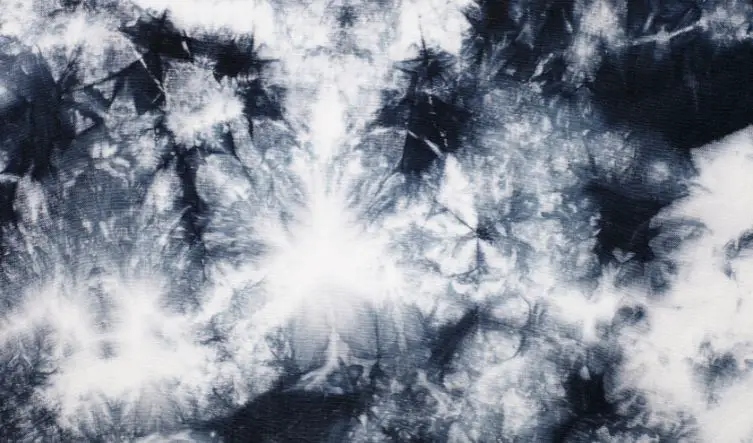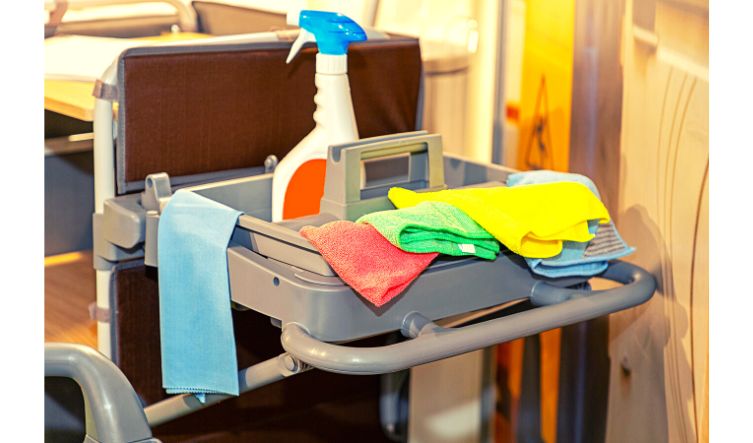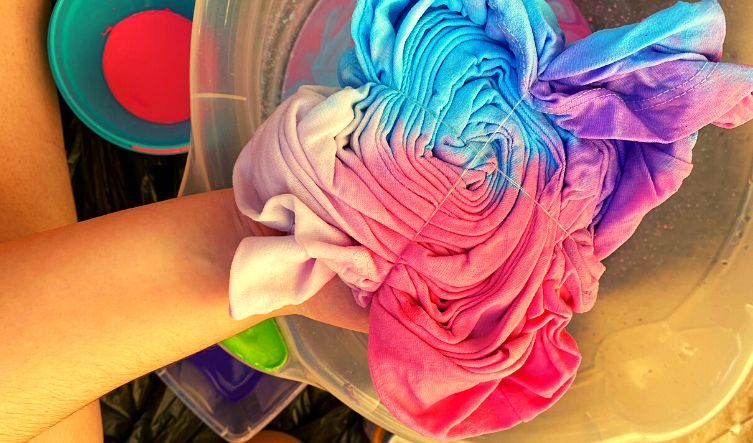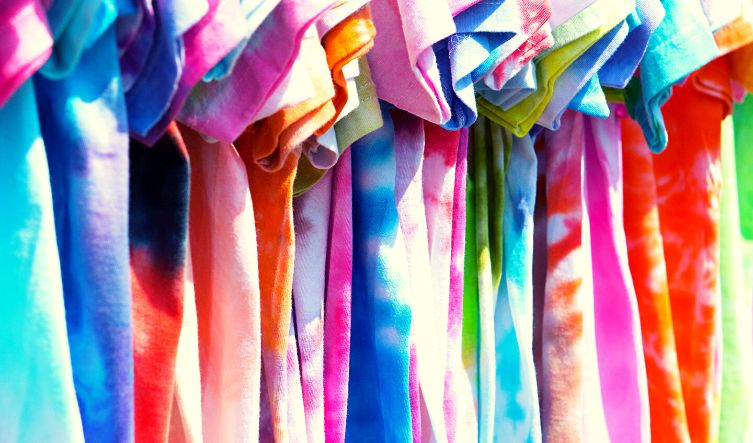There are many ways to dye fabric, and one of the most popular methods is tie-dying. This process involves tying knots in the fabric to create different patterns. It can be fun to add some personality to your clothes or accessories.
When it comes to tie-dyeing, there are a lot of different fabrics that you can use. Cotton is probably the most popular option, but did you know that you can also dye microfiber? In this blog post, we will teach you how to tie-dye your microfiber fabric!
Can You Tie Dye Microfiber?

Most tie dye enthusiasts know that you can use any fabric for tie dying, as long as it’s made of natural fibers. But what about synthetic fabrics, like microfiber?
Can you tie dye microfiber clothes? The answer is yes; you can tie dye microfiber. But there are certain types of microfibers you can use for dyeing.
Polyester microfiber, for example, is a good choice for tie-dying. This is because polyester is a crystallizable polymer, which means that the dye molecules can bond to the fibers on a molecular level. This results in a more vibrant and long-lasting tie dye design.
So if you want to add some tie-dyed microfiber to your wardrobe, go ahead and try it. Just be sure to use the right type of microfiber fabric to have a beautiful and vibrant result.
How To Dye Microfiber Polyester?

Dyeing microfiber polyester is slightly different from dyeing other fabrics, but it’s not difficult. Here’s what you need to know.
Microfiber polyester is a synthetic fabric, and as such, it accepts dye differently than natural fibers like cotton or wool. The key to successful dyeing is to use the right type of dye and to follow the manufacturer’s instructions carefully.
Two main types of dye can be used on microfiber polyester: acid dyes and direct dyes. Acid dyes are the best choice for most projects, as they produce the brightest and most vibrant colors. Direct dyes are less color-intense, but they’re easier to use and don’t require special equipment.
To dye microfiber using acid dyes, you will need:
- A pot or kettle for boiling water
- A stirring spoon
- A measuring cup
- A dye bath container (a plastic bucket or a large pot works well)
- Wine or vinegar (acetic acid)
- Salt
- Microfiber fabric
1. Fill the dye bath container with enough hot water to cover the fabric. Stir in 1 cup of vinegar or wine and 2 tablespoons of salt.
2. Add the dye powder to the water, following the manufacturer’s instructions. Stir until the dye is completely dissolved.
3. Place the fabric in the dye bath and stir gently until it is completely saturated with color. Let it soak for at least 30 minutes, then rinse well in cool water. Hang to dry.
Mix the dye with water in a small container to dye microfiber using direct dyes. Then, use a paintbrush to apply the dye to the fabric. Be sure to work in a well-ventilated area, and avoid getting the dye on your skin or clothes. Let the fabric dry completely before washing it.
When dyeing microfiber polyester, you’ll need to use more dye than you would for other fabrics. This is because the fabric is so dense, and the fibers are so small. You’ll also need to use hotter water than you would for other fabrics.
Once the dyeing time is up, rinse the fabric in warm water until the water runs clear. Then, wash it in the washing machine using the hottest water setting. Be sure to use a detergent that is designed for use with synthetic fabrics.
What Fabrics Can You Tie Dye? Can You Tie Dye Microfiber?

Any natural fiber fabric can be tie-dyed, including cotton, linen, wool, and silk. Synthetic fabrics like polyester and nylon can be tie-dyed, but the results are not always as vibrant as natural fibers.
The best fabrics for tie-dye are those that are 100% natural fiber and have a tight weave. Loosely woven fabrics or those with many stretches will not take the dye either and may even fall apart when you try to tie them.
Here are a few of our favorite fabrics that you can tie-dye:
Cotton: Cotton is the most popular fabric for tie-dye, and for a good reason. It takes the dye well and produces vibrant colors. It’s also inexpensive and easy to find.
Linen: Linen is a great alternative to cotton if you want something more upscale. It takes the dye well and produces beautiful results.
Wool: Wool is another great option for tie-dye. It produces rich, saturated colors and is very durable.
Silk: Silk is one of the most luxurious fabrics you can tie dye. It produces stunning results, but it is also the most expensive option.
Why Did My Tie-Dye Wash Out? Can You Tie Dye Microfiber?

There are a few reasons why your tie-dye might have washed out. First, let’s start with the basics. Tie dye is created by using a fabric dye. When you add water to the dye, it helps the dye to penetrate the fabric.
However, if you don’t use enough water, the dye won’t be able to penetrate the fabric as well and will wash out more easily.
Another reason your tie-dye might be washing out is that you didn’t let it set long enough. Fabric dyes need time to set, so be sure to follow the instructions on your dye package.
If you’re still having trouble, you can try a few other things. First, try using a hot water setting on your washing machine. The hot water will help the dye to set better.
You can also try using a fabric dye fixative. This is a product that you can find at most craft stores. It will help to set the dye and prevent it from washing out.
Finally, if you’re still having trouble, you can try hand-washing your tie-dye in cold water. This is a bit more time-consuming, but it can help to set the dye better.

Should you wet your shirt before tie-dying?
The general consensus is that it’s best to wet the shirt before tie-dying. When the fabric is wet, the dye will penetrate it more easily. Plus, it’s easier to tie-dye a wet shirt than a dry one. Soaking the fabric in water also helps to set the dye and prevents it from washing out.
Can You Tie Dye Microfiber? Does tie-dye have to be cotton?
No, tie-dye can be done on other fabrics as well. The most common fabric to tie-dye is cotton because the dye attaches better to the natural fibers of the cotton than on other fabrics.
However, you can use various fabrics to tie-dye, such as silk, nylon, and felt. Make sure that the fabric you choose can withstand being dyed multiple times.
FAQs: Can You Tie Dye Microfiber?
What fabric can you not tie-dye?
Tie-dyeing works best on natural fibers like cotton, rayon, and linen, as they readily absorb the dyes and hold the colors well. In contrast, fabrics made from synthetic materials like nylon, acrylic, or polyester tend to be less receptive to tie-dyeing because they do not absorb the dyes as effectively and can result in less vibrant and less permanent designs.
Can you dye microfiber towel?
Microfiber towels are typically made from synthetic materials like polyester and polyamide, which do not readily absorb traditional fabric dyes. As a result, dyeing microfiber towels can be challenging, and achieving vibrant or permanent results may be difficult. You may have better success using specialized polyester or fabric dyes, following specific dyeing instructions for synthetic materials, and considering that the results may not be as vibrant as on natural fibers.
What fabrics hold tie-dye?
Fabrics that are best for tie-dyeing are natural fibers like cotton, rayon, and linen. These materials readily absorb and hold tie-dye colors, resulting in vibrant and long-lasting designs. Natural fibers have the porous structure needed for the dye to penetrate and bond effectively, allowing for the creation of eye-catching tie-dye patterns that withstand repeated washings.
Can you tie-dye polyester fiber?
Tie-dyeing polyester fiber can be quite challenging because polyester is a synthetic material that doesn’t readily absorb traditional fabric dyes. Achieving vibrant and long-lasting tie-dye results on polyester often requires specialized polyester dyes and careful adherence to their specific dyeing instructions.
Conclusion: Can You Tie Dye Microfiber?
Can You Tie Dye Microfiber? In conclusion, tie-dyeing microfiber, which is typically made from synthetic materials like polyester and polyamide, presents unique challenges compared to natural fibers. Achieving vibrant and permanent tie-dye results on microfiber can be difficult due to its resistance to traditional fabric dyes. However, with the use of specialized polyester or fabric dyes designed for synthetic materials, as well as precise dyeing techniques, it is possible to add some color to your microfiber items, although the results may not be as vivid or long-lasting as on natural fiber fabrics.
Read more:
How to Make Tie Dye More Vibrant?
Can Mica Powder Be Used For Tie Dye?
Can You Wash Multiple Tie Dye Shirts Together?




